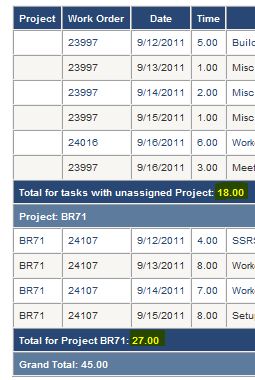I came across an interesting problem while enhancing an ASP.NET site, I needed to add a grouped
ListView to use it as a query screen with print capabilities.
The scenario is as follows: you have a list of records being displayed in a
ListView. Records are grouped (in my case, by Project) and you want to have
a group footer to total each group.

How can we get this done?
First, we can use the ListView LayoutTemplate to create the desired table structure:
<asp:ListView ID="lvGroupedLabor" runat="server"
style="text-align: center; font-family: Arial, Helvetica, sans-serif;
font-size: xx-small" ondatabound="lvGroupedLabor_DataBound">
<LayoutTemplate>
<table cellspacing="0" cellpadding="5" rules="all" border="1" width="100%">
<thead class='grouptot'>
<tr>
<th>Project</th>
<th>Work Order</th>
<th>Date</th>
<th>Time</th>
<th>Comment</th>
</tr>
</thead>
<tbody>
<asp:PlaceHolder ID="itemPlaceholder" runat="server" />
</tbody>
<tfoot>
<tr class='grouptot'>
<td colspan="6"><asp:Literal ID="litSubTotal" runat="server" /></td>
</tr>
<tr class='group'>
<td colspan="6"><asp:Literal ID="litGrandTotal" runat="server" /></td>
</tr>
</tfoot>
</table>
</LayoutTemplate>
<ItemTemplate>
<%# fTotalbyProject(false) %>
<%# fGroupingRowIfNewProject() %>
<tr class='data<%# Container.DataItemIndex % 2 %>'>
<td><%#Eval("project_cd")%></td>
<td><%#Eval("woid")%></td>
<td><%#Eval("labor_date", "{0:M/dd/yyyy}")%></td>
<td><%#Eval("labor_time")%></td>
<td><%#Eval("comment")%></td>
</tr>
</ItemTemplate>
</asp:ListView>
There are several interesting things to point out here:
- Notice how there is a row in the template for the group footer
<tfoot>? In my case, I decided to have a row to total per group and another row to total all the values. - The structure of the template is such that it will insert a header row for the group, followed by the Total of the last group, then the record rows. Therefore we will need to address how to insert a total for the last row and the grand total.
- The method
fTotalbyProject(false) is used to display the numeric total of each group. - The method
fGroupingRowIfNewProject() is used to signal a group break per row. - The style
<tr class='data<%# Container.DataItemIndex % 2 %>'> is a nice little trick to zebra the rows in the
ListView.
The code assumes that you have a few static variables defined that we'll be using with our class.
static string sLastProject = "";
static string sTotLastProj = "";
static decimal dLastSumTotal = 0;
static decimal dGrandTotal = 0;
static bool bTotalCntSt = false;
Let's review the fTotalbyProject method, it is used to display the "Total for Project (XXX):"
protected string fTotalbyProject(bool aMode)
{
if (aMode == false)
{
String sCurrentProject = (string)Eval("project_cd");
if (bTotalCntSt == false)
{
sTotLastProj = (string)Eval("project_cd");
bTotalCntSt = true;
}
if (sTotLastProj == sCurrentProject)
{
return string.Empty;
}
else
{
Decimal dGetTotalbyProject = fSumTotalbyProject(sTotLastProj, false);
String sNewRow = "";
if (sTotLastProj == " ")
sNewRow = String.Format("<tr class='grouptot'><td colspan='6'>" +
"Total for tasks with unassigned Project: {1}</td></tr>",
sTotLastProj, dGetTotalbyProject);
else
sNewRow = String.Format("<tr class='grouptot'><td colspan='6'>"+
"Total for Project {0}: {1}</td></tr>",
sTotLastProj, dGetTotalbyProject);
sTotLastProj = (string)Eval("project_cd");
return sNewRow;
}
}
else
{
Decimal dGetTotalbyProject = fSumTotalbyProject(sTotLastProj, false);
String sNewRow = String.Format("Total for Project {0}: {1}",
sTotLastProj, dGetTotalbyProject);
return sNewRow;
}
}
What we do here is return some HTML so the template displays the appropriate text for each group break.
As you have probably noticed, the fTotalbyProject method calls another method named
fSumTotalbyProject, which is the one that does the numeric sum of the records;
it takes a second argument to indicate if the total should be done by Project or calculate the grand total.
This function uses LINQ and assumes you have a LINQ DB Model previously defined.
protected Decimal fSumTotalbyProject(string aProject, bool bIsGrandTotal)
{
string aUserName = aUserNameVariable;
DateTime dStDate = Convert.ToDateTime(YourTextBox1.Text);
DateTime dEndDate = Convert.ToDateTime(YourTextBox2.Text);
TasksLinqDataContext db = new TasksLinqDataContext();
if (aProject == " ") aProject = "";
try
{
if (!bIsGrandTotal)
{
var dbTaskLabor = (from vtlbr in db.tasksTable
where vtlbr.staff_name == aUserName &&
vtlbr.labor_date >= dStDate &&
vtlbr.labor_date <= dEndDate &&
vtlbr.project_cd == aProject
select vtlbr.labor_time).Sum();
return dbTaskLabor;
}
else
{
var dbTaskLabor = (from vtlbr in db.tasksTable
where vtlbr.staff_name == aUserName &&
vtlbr.labor_date >= dStDate &&
vtlbr.labor_date <= dEndDate
select vtlbr.labor_time).Sum();
return dbTaskLabor;
}
}
catch (Exception Exc)
{
ErrorLbl.ForeColor = System.Drawing.Color.Red;
ErrorLbl.Text = Exc.Message;
return 0;
}
}
To signal that there is a new Project, we define a row in our template to display the project name each time there is a change.
The method fGroupingRowIfNewProject handles that logic. Again, we are just returning some HTML to add a cell to the table and display the text "Project : ".
The HTML is placed in the appropriate row, thanks to our template.
protected string fGroupingRowIfNewProject()
{
String sCurrentProject = (string)Eval("project_cd");
if (sCurrentProject == " ")
sCurrentProject = "Unassigned Project";
else
sCurrentProject = "Project: " + sCurrentProject;
if (sLastProject != sCurrentProject)
{
sLastProject = sCurrentProject;
return String.Format("<tr class='group'>"+
"<td colspan='6'>{0}</td></tr>",
sCurrentProject);
}
else
{
return String.Empty;
}
}
Finally, the below code in the DataBound event of the ListView is used to invoke the above functions one last time to display and compute the Total for the last group and then display the
GrandTotal for all records.
protected void lvGroupedLabor_DataBound(object sender, EventArgs e)
{
Literal lSubTotal = lvGroupedLabor.FindControl("litSubTotal") as Literal;
lSubTotal.Text = fTotalbyProject(true);
Literal lGrandTotal = lvGroupedLabor.FindControl("litGrandTotal") as Literal;
lGrandTotal.Text = "Grand Total: " +
Convert.ToString(fSumTotalbyProject(String.Empty, true));
}
Happy coding!
